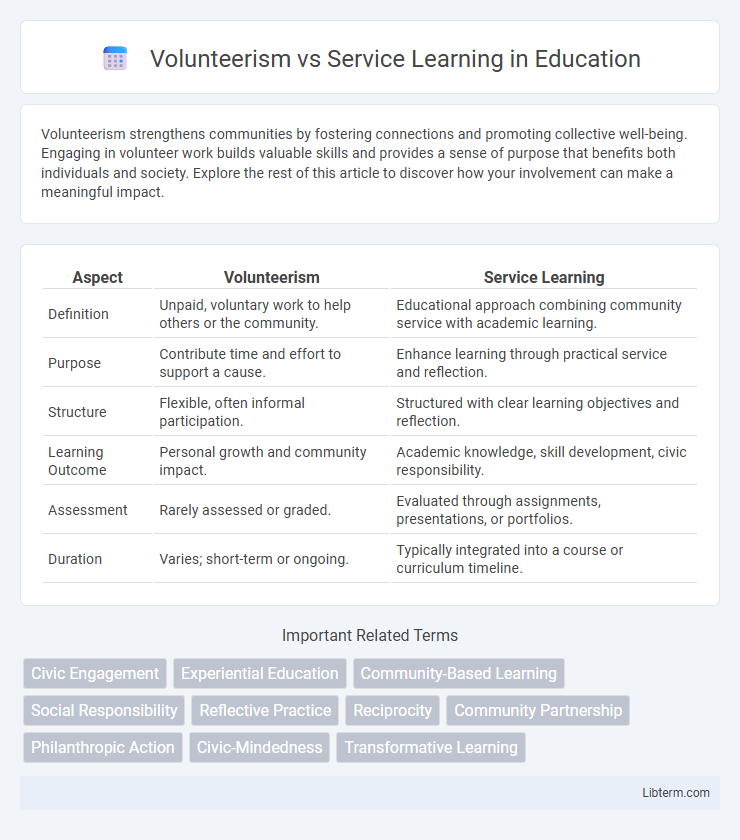Volunteerism strengthens communities by fostering connections and promoting collective well-being. Engaging in volunteer work builds valuable skills and provides a sense of purpose that benefits both individuals and society. Explore the rest of this article to discover how your involvement can make a meaningful impact.
Table of Comparison
| Aspect | Volunteerism | Service Learning |
|---|---|---|
| Definition | Unpaid, voluntary work to help others or the community. | Educational approach combining community service with academic learning. |
| Purpose | Contribute time and effort to support a cause. | Enhance learning through practical service and reflection. |
| Structure | Flexible, often informal participation. | Structured with clear learning objectives and reflection. |
| Learning Outcome | Personal growth and community impact. | Academic knowledge, skill development, civic responsibility. |
| Assessment | Rarely assessed or graded. | Evaluated through assignments, presentations, or portfolios. |
| Duration | Varies; short-term or ongoing. | Typically integrated into a course or curriculum timeline. |
Understanding Volunteerism: Definition and Key Concepts
Volunteerism involves individuals offering time and skills voluntarily to support communities or causes without monetary compensation, emphasizing altruism and social responsibility. Key concepts include motivated participation, community engagement, and personal fulfillment, distinguishing it from service learning's structured educational framework. Understanding these elements highlights how volunteerism contributes to societal well-being through self-directed, compassionate action.
What is Service Learning? An In-Depth Overview
Service learning is an experiential educational approach that integrates meaningful community service with instruction and reflection to enrich the learning experience and foster civic responsibility. Unlike traditional volunteerism, service learning aligns specific academic goals with community needs, promoting critical thinking, problem-solving skills, and real-world application of knowledge. This pedagogical method enhances student engagement by connecting coursework to societal impact, encouraging active participation and personal growth.
Core Differences Between Volunteerism and Service Learning
Volunteerism involves individuals offering time and effort to assist others without structured educational objectives, emphasizing altruistic contribution and community support. Service learning integrates meaningful community service with explicit academic goals, promoting reflection, critical thinking, and practical application of classroom knowledge. The core difference lies in service learning's intentional connection between service activities and curriculum outcomes, whereas volunteerism prioritizes voluntary action without mandated educational components.
Motivations: Why People Volunteer vs Engage in Service Learning
People volunteer primarily to contribute to their community, fulfill personal values, and gain social connections, motivated by altruism and a desire to make a positive impact. In contrast, service learning participants engage to merge academic objectives with real-world experiences, driven by educational goals, skill development, and reflective learning opportunities. Both motivations emphasize personal growth, but service learning integrates structured curriculum-based objectives, whereas volunteerism centers on individual choice and community service.
Educational Impact: Learning Outcomes in Service Learning
Service learning integrates community service with structured educational objectives, resulting in enhanced critical thinking, problem-solving skills, and civic responsibility among students. Unlike traditional volunteerism, service learning includes reflection activities that deepen understanding and promote retention of academic content. Evidence shows students engaged in service learning demonstrate improved academic performance and a greater sense of social awareness compared to their peers in standard volunteer programs.
Community Benefits: Comparing Impacts of Each Approach
Volunteerism fosters immediate community benefits by mobilizing individuals to address specific local needs, often resulting in short-term impact and increased civic engagement. Service learning integrates academic curriculum with community service, promoting deeper understanding and long-lasting social change through student reflection and skill development. Communities experience enhanced capacity and sustainable improvements when service learning bridges theoretical knowledge with practical application.
Reflection and Personal Growth: Volunteerism vs Service Learning
Service learning integrates reflection as a core component, encouraging students to analyze their experiences critically and connect them to academic content, which fosters profound personal growth and social awareness. Volunteerism often emphasizes the act of helping without structured reflection, potentially limiting deep learning and self-development opportunities. Structured reflection in service learning transforms community involvement into an educational experience, enhancing empathy, critical thinking, and long-term commitment to social change.
Integrating Service Learning in Academic Curricula
Integrating service learning in academic curricula enhances student engagement by combining community service with structured reflection and coursework, promoting practical application of theoretical knowledge. This approach fosters critical thinking, civic responsibility, and real-world problem-solving skills, surpassing traditional volunteerism's focus on altruism. Academic institutions that embed service learning modules experience improved student outcomes and stronger community partnerships.
Challenges and Best Practices in Both Models
Volunteerism often faces challenges such as lack of structured reflection and limited skill development, which can reduce long-term impact, while service learning struggles with integrating academic rigor and community needs effectively. Best practices in volunteerism include implementing ongoing training and promoting cultural competency to enhance engagement and effectiveness. In service learning, aligning projects with curriculum goals and establishing strong community partnerships are essential to maximizing educational outcomes and social benefit.
Choosing the Right Path: Volunteerism or Service Learning?
Choosing between volunteerism and service learning depends on the goals and desired outcomes of the experience. Volunteerism emphasizes altruistic community support without formal educational objectives, while service learning integrates meaningful community service with structured reflection and academic curriculum to enhance learning. Assess personal or organizational priorities such as skill development, community impact, and educational benefits to select the appropriate path.
Volunteerism Infographic

 libterm.com
libterm.com